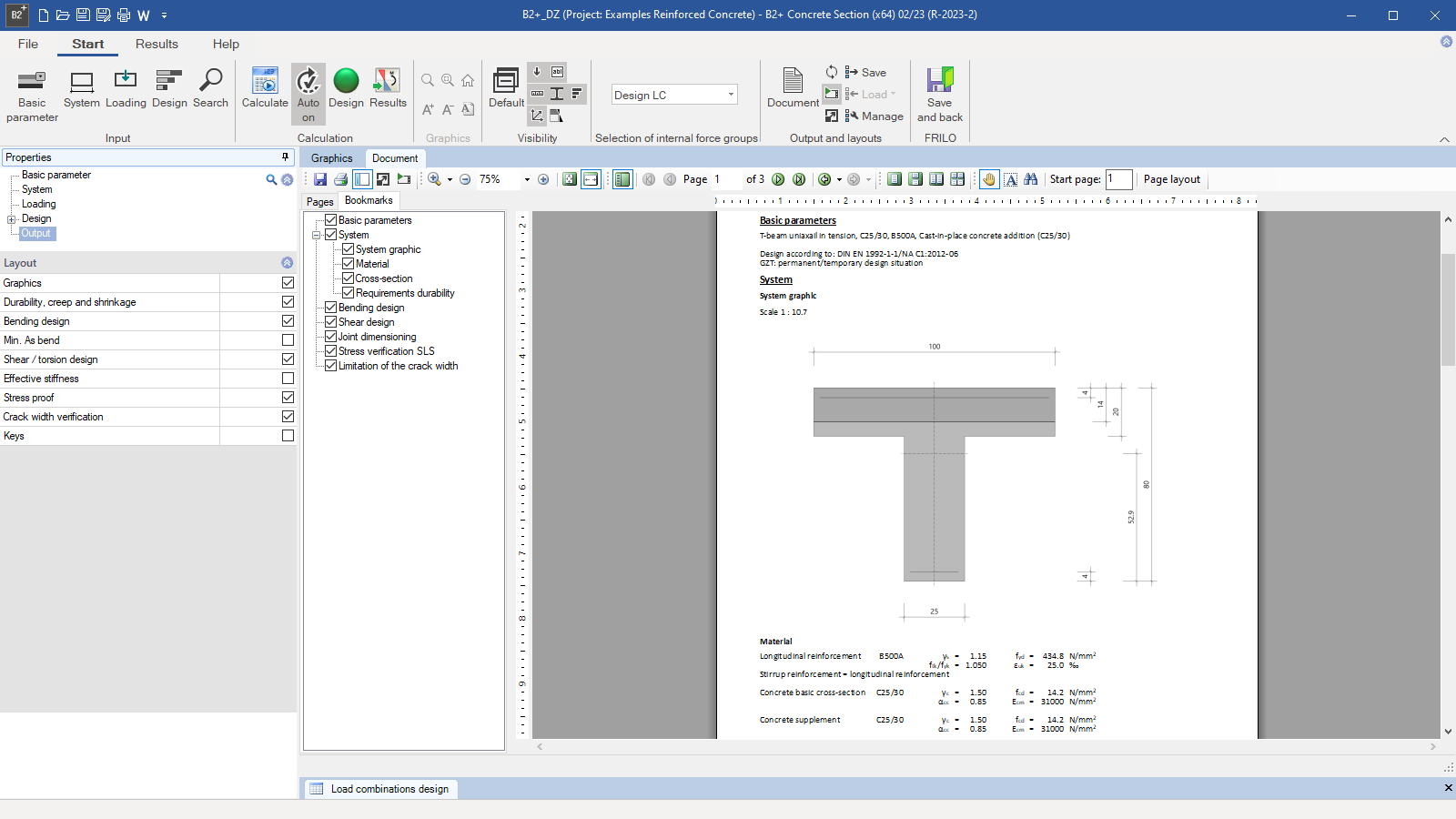
Verification of Reinforced Concrete Cross-Sections
B2+
With the program B2+, the design of reinforced concrete cross-sections can be performed. You can design cross-sections for bending with longitudinal force and for shear force. Furthermore, you can perform crack width verifications and stress analyses or determine the effective stiffness.
Discover now more programs from the section Reinforced Concrete!
SHOW MOREMaterial
- Concrete of the strength classes C12/15 to C100/115
- Lightweight concrete of the strength classes LC 12/13 to LC 80/88
- Concrete and steel with freely definable parameters
- Reinforcing steel of the steel grades B500A, B500B and BSt 420 S(A) in combination with the German NA (corresponding qualities for all other available NAs)
In addition to standard reinforcing steel, reinforcements made of glass fiber-reinforced plastic (Schöck Combar®) can also be used in accordance with DIN EN 1992.
Structural System
- Rectangular cross-section, uniaxial and biaxial
- T-beam, uniaxial
- Hollow box, biaxial
- Circular and annular cross-section, biaxial
- Layered cross-section, uniaxial
- Polygonal cross-sections and temperature analysis for rectangular and circular cross-sections with point reinforcement via additional option (see Design > B2-Poly)
Environmental conditions
- Detailed entry of the exposure classes and the resulting durability requirements (minimum concrete class, concrete cover and requirement class for the crack-width verification).
Cast-in-place complement
- Cast-in-place concrete complements can be entered for uniaxial cross-section types
- The height and the width of the cast-in-place complement as well as the joint width are freely definable
- Available joint finishing options are very smooth, smooth, rough and interlocked
- Optionally, an axial force perpendicular to the joint can be defined
- Selection options for the shear reinforcement (no lattice girders, only diagonal struts or with posts and diagonal struts)
Load-bearing capacity
In the reinforced concrete design, the strain state leading to failure is determined for given internal forces with unknown reinforcement. For the bending design, the method with a given reinforcement ratio can be selected, and for uniaxial loading, the kd‑method is available in addition.
Various design options are available. Optionally, tension stiffening can be considered in the determination of the effective stiffness. The state of strain in which the external and internal forces are in balance is sought after.
In the bending design, the user can optionally calculate the net cross-sectional area of the compression zone. The calculation can include several combinations of internal forces that are to be entered via a table.
Serviceability
A crack-width verification can be performed in accordance with EN 1992-1-1. Based on the crack formula (Eq. 7.8), the maximum limit diameter, for which the permissible crack width is observed, is determined for an external load corresponding to the decisive action combination and for a selected reinforcement.
The programme determines a minimum reinforcement in accordance with 7.3.2 for imposed bending on top and bottom.
Additional options
Temperature analysis with B2-Poly:
If the additional option B2-Poly is licensed, a verification in the accidental design situation fire according to EN 1992-1-2 (with National Annex) is possible for rectangular and circular cross-sections with general point reinforcement. The verification is carried out in accordance with the requirements of a general calculation method. It includes a FEM-based temperature analysis according to the parameters defined in the national annexes as well as a mechanical analysis in the form of determining the internal forces with the stress-strain curves of concrete and steel according to EN 1992-1-2 and determining the equilibrium with the external internal forces taking thermal expansion into account. Different fire resistance classes can be selected. In addition, various settings for concrete aggregate and steel production are available.
Document file formats
- Word
- Drucker
Output
- The user can define the desired scope of data to be put out via the options of the output profile
- The cross-section, the reinforcement and the state of strain of the selected verification can be represented in the graphical view
Import options
- FRILO XML
Export options
- Word
- FRILO XML
Reinforced concrete
- DIN EN 1992
- ÖNORM EN 1992
- BS EN 1992
- PN EN 1992
- NTC EN 1992
- EN 1992
News

FRILO launches version 2024-2 with powerful updates for structural analysis and design
Highlights include the optimised design of Schöck Isokörbe®, the advanced integration of DC foundation engineering programs into the FRILO environment and new RSX interfaces for detail verifications in steel construction.

Load determination for eight-floor perimeter block development with FRILO Building Model
Find out how the structural engineers at bauart Konstruktions GmbH determined the loads for an eight-floor perimeter block development in Frankfurt’s Europaviertel district using the GEO from FRILO.




